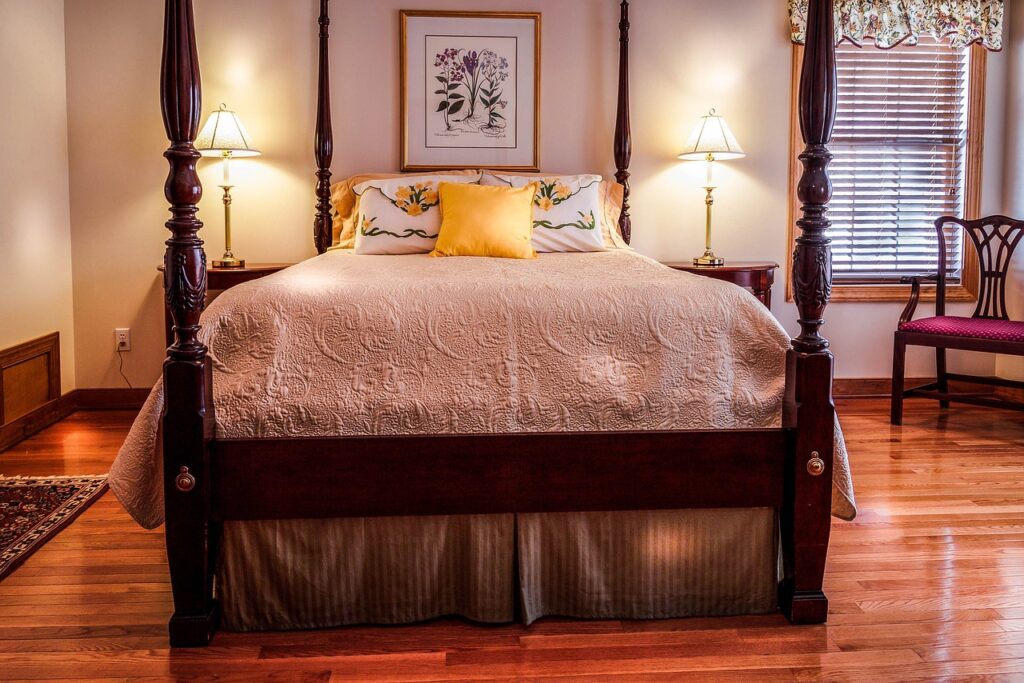Bedspreads are a common and versatile bedding option that serves several functions, including adding style and visual appeal to your bedroom. While they are not primarily designed to provide substantial warmth, their ability to offer comfort and coziness depends on various factors, such as their material, thickness, layering, and the climate in which they are used.

A bedspread is a decorative top layer of bedding that covers the entire bed, including the mattress and box spring. It typically drapes over the sides of the bed and reaches the floor on all sides, creating a neat and polished look. Bedspreads are designed to enhance the aesthetic of your bedroom, tying together the overall decor and color scheme.
Factors Affecting the Warmth of Bedspreads:
1. Material:
The material of a bedspread plays a significant role in determining its warmth. Bedspreads are available in various materials, including cotton, linen, polyester, silk, and blends. Natural materials like cotton and linen are breathable and lightweight, making them suitable for warmer climates or those who prefer cooler sleeping conditions. However, they do not provide significant insulation or warmth on their own.
- Cotton: Cotton bedspreads are known for their softness, breathability, and durability. They are ideal for summer or for individuals who tend to sleep hot.
- Linen: Linen bedspreads offer excellent breathability and moisture-wicking properties. They are comfortable in hot weather but may not provide substantial warmth in colder seasons.
- Polyester: Polyester bedspreads can provide a bit more warmth compared to natural materials. They are often chosen for their affordability and ease of care.
- Silk: Silk bedspreads are luxurious and smooth to the touch. While they are not known for their warmth, they can add an elegant and lightweight layer to your bedding.
2. Thickness:
Bedspreads vary in thickness, with some being thin and lightweight, while others are thicker and more substantial. Thicker bedspreads may offer a bit more warmth, but they are still not designed to provide the same level of insulation as blankets or comforters. The thickness of a bedspread can also impact its overall appearance on the bed, creating a fuller or more streamlined look.
3. Layering:
To increase the warmth of your bed when using a bedspread, layering is key. Bedspreads are often used in combination with other bedding layers, such as blankets, quilts, or comforters. This allows you to adjust the level of warmth according to your needs and the season.
- Blankets: Placing a blanket between your fitted sheet and bedspread can add extra insulation. Blankets come in various weights, from lightweight to heavyweight, allowing you to customize your warmth level.
- Quilts: Quilts are thinner than comforters but thicker than bedspreads. They can provide an extra layer of warmth without the bulk of a comforter.
- Comforters: In colder climates or during the winter months, many people use a bedspread in conjunction with a comforter. The bedspread serves as a decorative top layer, while the comforter provides the primary source of warmth.
4. Climate:
The climate in which you live and the season of the year can significantly influence the perceived warmth of a bedspread. In regions with milder or warmer climates, a bedspread may be suitable as the main bedding layer for most of the year. However, in colder climates or during the winter season, additional insulation will likely be necessary to keep you comfortably warm during the night.
- Warm Climates: In warmer regions, bedspreads made of breathable materials like cotton or linen can help maintain a comfortable sleeping temperature. The lightweight nature of these bedspreads is ideal for hot and humid climates.
The perceived warmth of a bedspread can vary from person to person based on individual preferences and comfort levels. Some individuals naturally sleep warmer or colder than others. Factors such as room temperature, humidity, and personal body heat can all affect how warm or cool you feel under a bedspread.
5. Personal Preferences:
The perceived warmth of a bedspread can vary from person to person based on individual preferences and comfort levels. Some individuals naturally sleep warmer or colder than others. Factors such as room temperature, humidity, and personal body heat can all affect how warm or cool you feel under a bedspread.
Practical uses of bedspreads:
While bedspreads may not be primarily designed for warmth, they serve several practical purposes in the bedroom:
- Aesthetic Appeal: Bedspreads add a touch of elegance and sophistication to your bedroom decor. They come in a wide range of colors, patterns, and designs, allowing you to coordinate your bedding with your overall interior design.
- Bed Protection: Bedspreads help protect your mattress and box spring from dust, dirt, and wear and tear. By covering the entire bed, they create a barrier that helps maintain the cleanliness and longevity of your bedding.
- Tidiness: Bedspreads create a neat and polished look for your bed. They can hide any clutter or storage items under the bed and provide a clean and organized appearance to your bedroom.
- Layering Options: Bedspreads are versatile and can be layered with other bedding elements, such as decorative pillows, shams, and throws, to enhance the overall look of your bed.
- Seasonal Decor: Bedspreads can be easily switched out to match different seasons or holidays. This allows you to refresh your bedroom’s decor without the need for a complete bedding overhaul.
Conclusion:
In summary, bedspreads are not typically chosen for their warmth but for their decorative and functional qualities. Their ability to provide comfort and coziness depends on factors like material, thickness, layering, climate, and personal preferences. While bedspreads can add style and elegance to your bedroom, they may require additional layers, such as blankets or comforters, to provide the desired level of warmth, especially in colder seasons or cooler climates. By understanding the role of bedspreads and considering their features, you can make an informed choice to create a comfortable and aesthetically pleasing sleeping environment.


